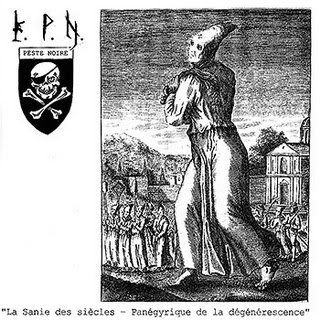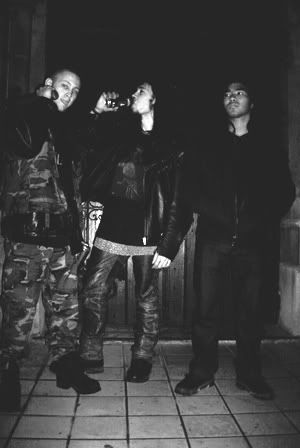And now for something completely different. The following article is a review I did on an album by the French black metal band Peste Noire. Posted here because it came in handy with a music discussion I'm having with julianozuca. Read if interested, although I must warn you that it may strike you as a bit pretentious. I was taking philosophy classes, and they tend to do weird things to your brain, hehe.
_______________________________________
Peste Noire - La Sanie des siècles - Panégyrique de la dégénérescence
About the art in music and why La Sanie des siècles is the epitome of guitar-based black metal
It is often forgotten that music belongs to the domain of art. In this context, I do not refer to the ****cal music that is traditionally identified with culture and art elitists. Instead, I refer to 'pop' music, or rather modern music, as nowadays the connotation that comes with 'pop' brings back nightmare images of such horrors as N*Sync and Britney Spears.
It's no surprise that in the minds of many people modern music is more closely identified with the mass culture represented by McDonald's' golden arches and the fake smile of Oprah Winfrey and the likes. After all, the commercial side of modern music is more easily accessible with channels such as MTV and The Box. When also taking into account most music used in commercials, movies, and videogames, we could state that the commercial side of modern music is so ubiquitous in our everyday lives that it completely overshadows the other side of modern music, vaguely defined as 'the underground'. Here, artistic expressions are far more likely to appear in the form of innovative, unconventional composing and unique musicianship. This side, the 'art' side of modern music, is not always easily accessible. The sound of a certain innovative band, or even an entire genre, may differ so greatly from anything we're familiar with that it takes a long while to get used to, or the releases of said band may be so obscure that one will have to resort to mail order websites rather than simply walking into a local record store.
These two features can easily be applied to the back metal genre. Starting out as a ****that was to be the most extreme form of metal music, black metal evolved into a very pluriform musical entity over the years. Sometimes it's more of a centre in a network of extreme yet strangely spiritual music which are only similar in some basic features. People who compare Borknagar to Fleurety will realize that black metal is not to be captured within a strict definition with tight-set, dogmatic borders, although there will always be people who claim otherwise. Black metal also differs from 'normal' metal and hard rock music in its attitude: the sex, drugs & rock 'n' roll-attitude that almost automatically comes with such bands as Metallica and Motörhead starts to disappear once you enter the black metal underground, and is often completely substituted by a disgust for the modern world, and a longing for a return to ancient times.
Whilst keeping in mind that black metal is but a vague term, it's perhaps strange to claim that Peste Noire's debut album, La Sanie des siècles - Panégyrique de la dégénéresence ('The Sanies of the Centuries - Ode to Degeneration'), is black metal of the purest kind. Yet, at the same time, this album proves what was said earlier: for while paying obvious homage to the black metal tradition, with influences from bands such as Burzum being quite easily detectable, Peste Noire carries this tradition to a whole new level with tons of innovations. The very concept of black metal itself is being carried out to near perfection on this disc.
The album contains nothing out of the ordinary (except maybe an excessive use of guitar solos) in the sense that it has all been done before in one form of another, but most of it has never been done so well. Peste Noire, led by the band's singer and (lead) guitarist, who goes by the name of La sale Famine de Valfunde (or simply Famine), plays a very solid, guitar-based ****of black metal. The music is more melodic, however, than that description suggests due to the strong presence of acoustic guitars, the aforementioned use of guitar solos, and the varied songwriting. This concept is materialized greatly by the ****musicianship of Famine (guitars), Winterhalter (drums), and Indria (bass). Alcest and Amesoeurs mastermind Neige occasionally contributes to the collective in the form of guest vocals and organ playing.
From left to right: Famine, Winterhalter, Indria.
Starting from the intro track, Nous sommes fanés (which is, as someone once mentioned, probably the most French song ever made), it's clear that Peste Noire takes us on a ride through sickness and depravity, which completely justifies the album's title. Musically clad in a medieval atmosphere, the lyrics are a mixture of old (and controversial) French poetry and Famine's own work. While one may expect there to be a considerable gap in quality between the borrowed literature and Famine's own efforts, the latter person doesn't fail to keep the level of the lyrics consistently high. This is remarkable, seeing as the ****c literature Famine used for his songs comes from such famous authors as Charles Baudelaire and Christine de Pisan. Famine didn't write or select the poetry at random: all of the lyrics essentially deal with some form of despair (though not in an angsty way), hopelessness, chaos, and indeed the entire concept of degeneration and decay. All of the lyrics, however, are in French, and those who don't understand a word of this language may not be able to uncover the treasure that is La Sanie des siècles in its entirity, seeing as the lyrical concept is so magnificently interwoven with the music. Moreover, with the music of every song reflecting the emotions of the lyrical content so well, it's debatable whether Peste Noire is paying homage to the ****c authors of his country, or if the ****c authors are paying homage to Peste Noire. A dubious statement by any standard, but I wouldn't say this if I wasn't totally convinced that Famine is one of the most talented and unique artists in the metal scene.
To illustrate the surprising consistency of the lyrical concept, despite the mix of ****c poetry and original work, I will shed a light on two fragments of this album's lyrics. The lyrics from the first song, Spleen, have been taken from a poem of the same name by Charles Baudelaire, while the lyrics from the second song, Des médecins malades et des saints séquestrés, have been written by Famine himself.
Spleen
"Et de longs corbillards, sans tambours ni musique,
Défilent lentement dans mon âme; l'Espoir,
Vaincu, pleure, et l'Angoisse atroce, despotique,
Sur mon crâne incliné plante son drapeau noir."
- "Spleen" by Charles Baudelaire in Les Fleurs du Mal, 1857.
("And long hearses, with no drums, no music,
File slowly through my soul: Hope,
Conquered, cries, and despotic atrocious Agony
Plants on my bent skull its flag of black."
- Translation by Geoffrey Wagner, 1974.)
Des médecins malades et des saints séquestrés
"Abois, pogroms, razzias! Assourdissant chaos!
Vocifèrent les serfs de l'haute Gestapo:
Les dandys de Satan aux lourds casques d'acier
Entassent dans les trains d'éternels vacanciers"
- "Des Médecins Malades et des Saints Séquestrés" by Famine, 2003.
("Terror, pogroms, razzias! Deafening chaos!
The serfs of the poncy Gestapo are swearing:
The dandies of Satan with heavy helmets of steel
being stapled upon the trains of eternal tourists")*
The mixture of sorrow and chaos that shines through in both fragments is easily noticeable, with the music both being extremely emotional and defying sanity itself with chaotic brutality. With that, La Sanie des siècles could be considered a concept album. Not because the songs tell different chapters of the same story (like on Dimmu Borgir's In Sorte Diaboli), but because all of the songs reflect a common idea, or 'concept'. The music is surprisingly consistent with this idea - surprising because early versions of many of the songs on this album previously appeared on different demos over a timespan of approximately 4 years.
Due to the unconventional song structures, harsh sound, and the depraved lyrical and musical content, this album is not likely to appeal to those who have never appreciated black metal, or are just plain unfamiliar with it. For those who know how to appreciate it, though, La Sanie des siècles is the pinnacle of extreme music. It perfectionizes concepts mostly shaped during the third wave of black metal, with Peste Noire not failing to add its own characteristic sound. Although the band draws heavy inspiration from the aforementioned Burzum and other contemporary black metal artists, Peste Noire once again out****s nearly everything they pay homage to.
All of that being said, La Sanie des siècles - Panégyrique de la dégénérescence is truly a work of art in the literal sense of the word. It testifies of the talent of the young Famine, who proves like no other that black metal is a form of (neo)romanticism: Famine is compatible with the aesthetics of the romantic artist, being both the genius and the outcast that were hailed during that era. The musical concept he constructed shows obvious signs of romanticism as well, with Famine attempting to describe (both musically and lyrically) the inexplicable beauty of things that may be beyond our control or comprehension, near impossible to capture in words, but therefore no less real, as within this romantic context, emotion is just as big a part of knowledge as ratio. In this sense it is unclear in what age the concept of Peste Noire is situated artistically: the themes and atmospheres obviously coincide with the Dark Ages, but are Peste Noire satanic minstrels telling us tales of degeneration, despair, and decay, or are they tortured romanticists speaking of long forgotten times because they are unsatisfied with the present? In any case, the use of modern instruments and techniques doesn't prevent us from occasionally being fooled into believing that this is truly music from a long-forgotten time. While this is not the case, it certainly is music from another world, metaphorically speaking. In conclusion, Peste Noire have created a pretty much flawless work of art that basically shouldn't be missed out on by any fan of (extreme) metal.
Line-up
La sale Famine de Valfunde - guitars and vocals; bass on track 5
Indria - bass
Winterhalter - drums and tambourin
Neige - vocals on track 7; organ; drums on track 1 & 8; bass on track 8
Tracklist:
1. Nous sommes fanés (2:18)
2. Le mort joyeux (4:40)
3. Laus Tibi Domine (6:57)
4. Spleen (5:48)
5. Phalènes et pestilence - salvatrice averse (11:46)
6. Retour de flamme (4:18)
7. Dueil angoisseus (7:02)
8. Des médecins malades et des saints séquestrés (9:09)
All music and lyrics written by Famine, except for track 2 & 4: lyrics by Charles Baudelaire; track 7: lyrics by Christine de Pisan.
*Translation may not be 100% accurate, seeing as some words don't have a proper equivalent in English.
Thanks to Reliability of 1337Planet.net for corrections.